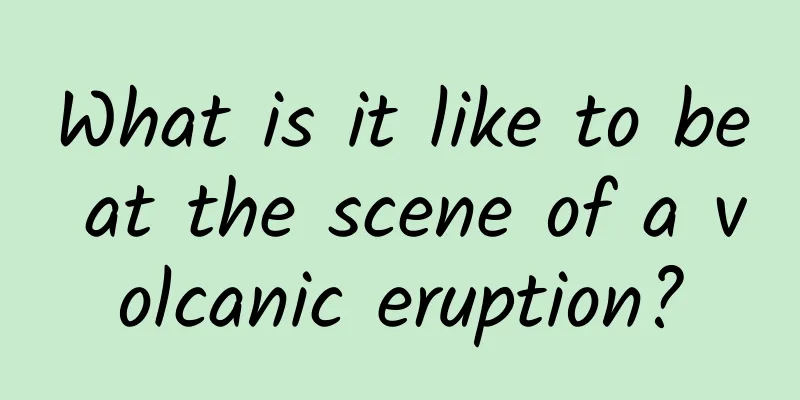What is it like to be at the scene of a volcanic eruption?

|
Perhaps you have seen videos showing volcano enthusiasts going deep into volcanoes to collect fresh lava samples. Such scenes are terrifying. We can't help but ask, what is it like to be at the scene of a volcanic eruption? Although volcanic eruptions are fierce, they do not just happen. They have to go through complex geological evolution and wait for all conditions to mature before a large-scale eruption will occur. In short, a volcanic eruption is when underground magma passes through a specific channel, is affected by pressure, is ejected to the ground, and then gushes out from the crater, thus forming a complete eruption process. Even for a modern active volcano, the eruption mode will be affected by many factors, such as the thickness of the earth's crust, the properties of magma (temperature, viscosity, density, etc.), the pressure in the underground magma reservoir, the shape of the volcanic channel, the volcanic eruption environment (on land or underwater), etc., which make the form of volcanic eruption vary greatly. Take magma for example. Magma can flow and has the properties of a fluid. The flow capacity of magma is mainly restricted by its viscosity. Therefore, the viscosity of magma has a great influence on the eruption mode of volcanoes and the type of pyroclastics. Underground pressure is high, and gases are compressed in magma. When magma gradually approaches the surface, the pressure decreases, and these gases gradually form bubbles and escape. The picture comes from Tuchong.com If the viscosity of the magma is relatively high, the gas cannot be released and will eventually break up the magma and explode from the crater. Large chunks of magma will be blown out to form volcanic bombs, and the fine debris will become volcanic ash. Therefore, the same volcano will erupt in different ways at different times. The viscosity of the magma is mainly determined by the silica content. The higher the silica content, the greater the viscosity and the weaker the fluidity. Generally speaking, there are several types of volcanic eruptions: If the channel for magma eruption is long and narrow, it is called "fissure eruption". This type of eruption generally does not cause an explosion. It is more like squeezing out toothpaste. It is relatively safe and will not produce a large amount of volcanic ash. The second type of volcanic eruption is called "melt-through eruption". Because the crust is relatively thin, the pressure of the underground magma is high, which pushes the crust open and a large amount of magma gushes out. This is called a melt-through eruption. However, the crust of the continental plates is generally thicker now, so this type of eruption is not common. The third type of volcanic eruption is called central eruption. Continental plates collide with each other to form high mountains, but the mountains are hollow in the middle, which provides a channel for magma to flow out. As the continental plates continue to shake, the pressure increases, and finally the magma erupts. It is also a central eruption, which is divided into three types: quiet, intermediate and explosive. Hawaiian volcanoes are typical examples of quiet eruptions. During an eruption, only a large amount of magma overflows from the crater and flows slowly down the hillside. The magma has a high temperature and low viscosity, and there is no explosion. It flows out quietly and is relatively safe, and is not likely to cause casualties. Therefore, Hawaii is also a holy place for volcanologists to study volcanoes. Intermediate eruption is a transitional type between quiet and explosive eruptions. Most of the time it is a quiet eruption, occasionally accompanied by one or two explosive eruptions. The last type of explosive eruption is very scary. It will produce a violent explosion and spew out a large amount of gas and volcanic debris. The area within a radius of more than ten kilometers will become a scorched earth. In 1902, the eruption of Mount Pelée on the "Martinique Island" in the eastern Caribbean Sea belonged to this type. Only three people survived out of the 30,000 residents on the island. In 79 AD, Mount Vesuvius on the east coast of the Bay of Naples, Italy, erupted explosively. The ancient city of Pompeii, 13 kilometers away from the volcano, was instantly covered by high-temperature magma. It was not until the middle of the 18th century that the ancient city of Pompeii was excavated. Many of the victims were in the posture of running away. This is the terrible volcano. This article is a work supported by Science Popularization China Starry Sky Project Author: Dong Hanwen Reviewer: Zhang Yuxiu (Associate Professor, School of Earth and Planetary Sciences, University of Chinese Academy of Sciences) Produced by: China Association for Science and Technology Department of Science Popularization Producer: China Science and Technology Press Co., Ltd., Beijing Zhongke Xinghe Culture Media Co., Ltd. |
>>: The culprit for allergies has been found, it's not flowers, but...
Recommend
It is said that getting more sun exposure can supplement calcium, but do children still need sunscreen?
Summer is coming, and many people are using sun p...
What are the common http status codes?
For those who have just started SEO website optim...
A complete collection of essential operation and promotion tools for new media professionals!
Here's the thing, I'm a person who loves ...
Junxiu Yuzhang: Nanchang, the "invisible man" in China's urban world, is becoming more high-profile!
Nanchang The capital of Jiangxi Province It's...
Check the price of Shigatse marriage and love mini program agent. How much is the price of Shigatse marriage and love mini program agent?
How much does it cost to be an agent for a marria...
What are the reasons for high display and low clicks or low display and low clicks in Baidu bidding promotion?
During the actual operation of SEM bidding promot...
How much does it cost to develop a Harbin nail art mini program? How much is the price for developing a Harbin nail art mini program?
How much is the price for developing a Harbin nai...
The surrender sleeping position is popular! Is it a problem if someone sleeps until their arms become useless?
The topic "I like to raise my hands above my...
JISHI Auto accelerates its layout, Weiqiao Group provides support and invests $1 billion in Rockwell Automation
September 22, 2023, Shanghai: Weichai Group has m...
How much does it cost to produce a short video of African mercenaries holding signs and shouting?
As the Wuhan epidemic slowly dissipates, major co...
84-year-old Japanese grandmother: An independent female IOS developer, a legendary life!
[[345816]] This article is reprinted from the WeC...
How much profit can you make from live streaming sales on Douyin?
The sales of goods on Douyin have hit new highs, ...
Young people's first car should be sporty, fashionable and economical. Emgrand GS can satisfy you.
Nowadays, more and more young people have entered...
Analysis of 5 aspects: pain points and opportunities in mutual finance operations
There don't seem to be many articles on Inter...
National Day brand marketing tactics, take it and you’re welcome!
National Day is coming, are you ready for your ma...









